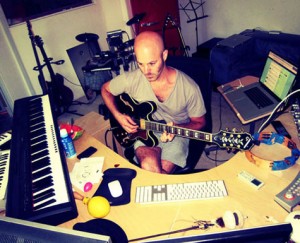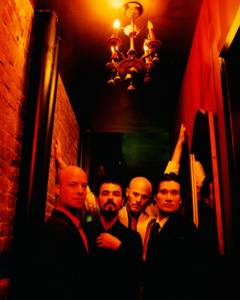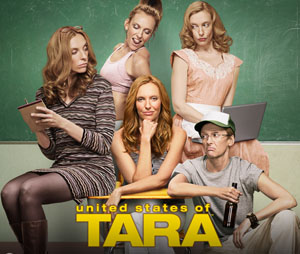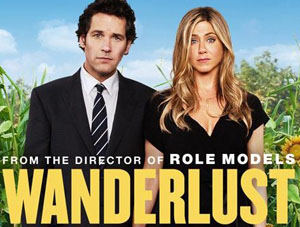From Post-Hardcore to Post-Production: Craig Wedren & The Road to Wanderlust
LOS ANGELES, CA: I’m sitting in Craig Wedren’s new studio, conveniently located in his backyard in Hollywood. Affectionately referred to as “Pink Ape”, this is where Wedren has been working for the last six months, fulfilling a lifelong dream of having a spacious and comfortable studio of his own in which to compose music for film and television projects.
While these days he may be most known for his film scoring projects, Wedren’s roots are in the 90s alternative rock scene. As the frontman for the acclaimed rock band Shudder To Think, Craig and his bandmates attracted a dedicated audience with a taste for unusual melodies and meters. And in the late 90s, as the independent film scene in NYC was flourishing, the band began delving into the world of film music.
Some of the band’s friends were filmmakers who wisely conscripted Shudder To Think for film scoring projects – specifically, Lisa Cholodenko’s High Art, Jesse Peretz’s First Love, Last Rites, and Todd Haynes’ Velvet Goldmine.
After Shudder to Think called it quits, Wedren and bandmate Nathan Larson went ahead to build successful careers as composers for film and TV. Wedren has since amassed an impressive resume of work, with a wide array of projects from Cholodenko’s Laurel Canyon to Richard Linklater’s School of Rock to HBO’s Hung and most recently the new David Wain feature – out this past Friday – Wanderlust.
Craig and I both moved from NYC to L.A. around the same time, and I’ve been lucky enough to work with him on a few projects out here. I thought it would be fun to sit down and delve a little deeper into his background and process as a film composer. So, back at “Pink Ape” we had a nice chat…
Tell me about your transition from rock band to film score composer. Seems like it was a natural move for you…
Well, I’d started off playing in bands, but I always had a secret 4-track life. In college at NYU, I was always making ambient, soundtrack-y kind of stuff late at night. A lot of my friends were in the film school, and since I was “band guy” whenever people needed music for their student projects, they’d ask me. A lot of those same people ended up forming the comedy group The State, and they needed music for their – then live – theater show, which was subsequently picked up by MTV.
So I would do some of the music, and my good friend Teddy Shapiro would do a bunch of the scoring because I wasn’t conservatory-trained particularly, I was just kind of punk-rock about it and had some fun ideas. And then, gradually, my friends started making real movies, and Shudder to Think started getting more and more interested in film soundtracks.
When the band broke up, we were all pretty tired of being on the road and having to do that write-record-tour cycle; and composing film soundtracks seemed like a great way to stay creative, do lots of different kinds of music, and not have to pander to record company “assignments”. We didn’t have families at the time, but it definitely turned out to be a practical thing once we all got married and started having kids, because, here we are, sitting in my backyard and I get to roll around with my kid, roll around with my guitars, and work on music for movies, songs, and TV shows.
And all my friends from growing up are making really big movies, case in point, Wanderlust – David Wain, who’s my oldest friend, directed it.
How nice!
Well David, and this other guy Stuart Blumberg, and I were best friends since we were four years old. Stuart just directed his first movie, Thanks for Sharing, which is what I’m working on right now…and he co-wrote The Kids Are Alright with Lisa Cholodenko – I actually introduced the two of them.
As far as getting started though…it definitely took about a decade or so of re-booting after Shudder to Think, because people, rightly, thought of me as this poncy lead-singer type.
But over that time period you really did quite a few movies.
I did, but it was like one movie a year, or maybe two; occasional TV music and theme songs. And it was all New York independent film, and so it was barely cobbling together a career. Fortunately I didn’t have a wife or kids at the time…I could just eat beans, or Bereket lentil soup. But then when we moved out to LA it picked up a bit, there was a lot more work.
Yeah, so tell me about that – why did you decide to relocate out here? What was the impetus for that move?
I always wanted to live in Los Angeles. New York was always the home of my heart, but second to that, Los Angeles was a romantic obsession of mine because of the LA hardcore scene of yore. Bands like X, The Germs, Black Flag, and Minute Men obsessed me when I was a kid. And the whole “radical sun culture” out here was always like titillating and scary to me. It’s more just scary now that I live here. So I always had it in my mind, being a film and music geek – it’s kind of the obvious repository.
My wife Meggan and I were living in New York, in a fourth story walk-up and she was pregnant, and we needed to figure out what was going to happen. Did we want to stay in New York? Or move to Brooklyn, or Jersey, or upstate? I happened to be working on David Wain’s last movie, Role Models, and it was posting out here in Los Angeles. So I needed to be out here anyway, and we figured, what the hell – let’s try it out.
Meggan’s brother, Tom Lennon, who was part of The State and a friend from my NYU days lived out here as well, and lots of other friends had also migrated out, so it was a pretty easy move community-wise. Culturally it was definitely a shocker. The combination of all the things I romanticized when I was younger – which of course are not romantic at all once you get into it – and suddenly having a kid was a lot, but now it’s great!
So you basically came out here to work on “Role Models”?
Yes, and at the time I was up for two HBO shows: One was Hung, and the other was Bored to Death. Bored to Death was New York based, and Hung was here in L.A. And I was like, let’s see, maybe I’ll get one of these and it will sort of help us…not have to make a decision. I ended up getting Hung, so it was a great reason to come and also took some of the weight off of having to make a “grown-up” decision about what to do…(laughs).
And then United States of Tara followed right on its heels?
Yeah, what happened there was that they had a different composer for the first season, and for whatever reason, they wanted to change it up for the second season.
So that happened and confirmed that you should stay?.
Yeah, exactly, and the minute I got here lots more work started happening in film and TV. And literally, just walking around, going to a restaurant, running into people from my life being like “What are you working on?” I love that. If anything I’m a bigger geek for all that stuff than I ever was… which is to say, as much as a geek as I ever was, but less of a snob than I used to be. So I’m way more open to like, “Let’s try it!, you seem like a good person, this seems just cockamamie enough that maybe it will be awesome.”
So you’ve found it easier to work and do business here?
Yeah, well I mean I was always busy in New York, but it was just harder financially speaking. And here I’m busy and I’m able to justify my career. (laughing)
Yeah, you have a studio in your back yard now!
Exactly! It’s pretty dreamy…
Great, well let’s talk about Wanderlust – you obviously got involved because of David (Wain) and you guys have always worked together.
And Ken (Marino) who co-wrote it. He and David were in The State together and they were actually my roommates in college. They’ve become a writing duo, and I first worked with the two of them on the movie The Ten.
So did they have a specific idea about what kind of music they were looking for? And how they wanted it to be presented?
It was a very experimental process, although there were some very clear pointers and clues in the script, which were that the bulk of the movie took place on a modern hippie commune. So we knew there was going to be a lot of “stoner-jamming” going on. This immediately makes you think there’s going to be a lot of acoustic guitar, bongos, and like, ukuleles, upright pianos – whatever’s around the house/commune.
So that was a nice starting point, and that’s what I try to look for. I try and appreciate, in a movie or TV show, when there is an obvious home plate. And then it can go wherever it wants from there. Like with Wanderlust it went in ten different directions.
There are three different sections to the movie: The Manhattan section, which is in the beginning. David and Ken had used a song from an old band of mine, called Baby, as temp – a jagged electro-rock thing and that tone seemed to work for the city. So by the time we got to the commune in the country, everything got very acoustic and rough around the edges – more performed, less “on the grid” as it were. So you have a sense of this journey and a sense of things becoming more earthy…less made of glass. This was all definitely clear from the script.
Then the details were just a matter of experimentation and throwing things up on the screen and watching them, playing them for people, and trying things out. The blessing and the curse of working – for which I am so fortunate – with so many of my old friends is that I tend to come into projects very early on, sometimes even in the script stage, which can be a mixed blessing because most movies go through such radical changes. It then becomes hard to keep the music tonally consistent. Whereas if you are getting a locked picture and you aren’t hired until the end of the process – once everything is shot, edited and the story is very clear – than you don’t wind up with as many vestigial cues.
You have the opportunity to stick with more of your original ideas and not get rid of ideas you’ve become attached to…
Yeah, but also, like with Wanderlust, which I worked on for about nine months, it ultimately became a situation in which we were using a real hodgepodge of things that had worked over that time period. So how could they be related thematically, and sonically?
The challenge was to create something that was a cohesive, unified score when you’ve gone through so many different identities with differing narrative directions. To tie it in a nice bow and not have a schizophrenic/schizo-phonic collage was definitely a challenge. Having to be super micro about focusing on the scene, the moment, the character arc, the relationships; and then having to get macro and be like, does any of this connect?
Frankly, a lot of times with modern movies, and I think particularly with comedies, because they are so moment-oriented, the traditional elegance of a classic score sometimes gets tossed out. You end up with a lot of stings [2-6 second long pieces], which is fine, and it certainly works – again, specifically for comedies – because nobody cares that much, they just want to laugh. But there really is something to be said for a “sharp-dressed man”, it’s like you want an elegant score that makes sense overall, and could be considered a cohesive piece of music even without being tied to picture.
Well you wouldn’t be doing your job otherwise…
Exactly, and yet many great composers wind up writing these slightly schizophrenic piecemeal scores these days because of the way movies can now be made.
So many cooks…
So many cooks, and editors are throwing in their ideas temp-wise with what they think works, Directors are putting in what they think works…the composer is trying to get their voice in somewhere but aren’t usually or necessarily in the same facility, physically, as the editors and the director. So there are different factories running at the same time. It becomes a cacophony of ideas. I really do think since Final Cut Pro, and Avid, that it’s been a blessing and a curse for composers.
The same thing obviously with DAWS, Pro Tools and the like. That said, how do you like to work? Do you have a set process and set of tools, players, etc?
For better and for worse I try to come at it pretty new for every project. I definitely start with a very basic watching of the scene, or the movie, looking at it with and without temp music. And then, for instance, I’ll start a scene with a tempo or a rhythm, some kind of pulse that fits.
I think because my roots are in being the “melody guy” – being the lead singer in a band – I think that dialogue to me is analogous to vocals, I’m trying to find something that grooves with “vocals”…tempo-wise, emotionally, dynamically; and so the first thing I do is find that tempo that gels and seems to sit right with the dialogue and the edit. It doesn’t mean it has to be on every cut, to be a really literal hip-hop “flow” style – it just has to somehow sit right.
By that point I’ll have ideas about instrumentation and sounds, or at least what world it should be in, depending on the genre of the film of course. Sometimes it’s very obvious that a particular film requires a particular style of music. With Wanderlust the obvious place to start was with acoustic guitar when we were on the hippie commune. It’s always nice to have those clear sonic clues. But honestly it’s mainly f**cking around in the kitchen, the laboratory…
So you’ll perform the majority of the stuff yourself? Or do you use a lot of samples and try and bring people in?
It’s definitely a hodgepodge. Everything that I can play, I do myself. Increasingly, just because when I come into a picture it’s usually changing so much I wind up using a lot more samples and MIDI stuff, just so everything doesn’t have to be re-performed every time there is a picture edit. Certainly in the last year since we’ve moved into our new house and I have this beautiful facility, I’ll bring people in and have really fun group sessions, which changes the vibe of everything; it let’s things breathe more, it opens it up. It brings more diversity, like a personality into the music.
In fact, before Shudder To Think broke up, I really had envisioned that we would grow into a full music-service group where we would make records and tour when we felt like it, produce other bands, write songs, compose film scores, produce film scores, and that it would be a sort of film and music collective. Obviously that didn’t work out. But what seems to be happening now with my core team and revolving members, like you, is that it feels kind of like that dream coming true. It’s starting to feel more like what a functioning modern band would be, what I had thought about during Shudder to Think.
It makes it more fun; the weight of responsibility is spread out in opposition to doing everything yourself in a very solitary way…which isn’t so fun…It can be rewarding, satisfying, and deep in a writerly kind of way, but not fun in a “band” kind of way. So it’s really nice to have some of that back. I’ll be curious to see how it evolves…
And you do everything in Pro Tools, yes?
Yes. I had this funny experience around 1999, working with this guy Jimmy Harry, who is a big pop songwriter and producer. I was working over at his house when I was still signed to Epic records, but after Shudder to Think had broken up…We were working together writing songs, and he was a Pro Tools whiz before I had it, or the money for it, and I had that experience where I was sitting in the room and my mouth would be watering because all I wanted to do was get my hands on it, because I knew there was stuff that I had to say using Pro Tools.
So I had a crash course in Pro Tools with my very first post-Shudder to Think TV scoring job. This music supervisor named Tracy McKnight who had hired Shudder to Think for High Art took a major chance and hired me for this hour-long ABC TV series called Wonderland, which Peter Berg was directing. Literally, my experience with TV up until that point was doing four to twenty second stings for The State. I had NO CLUE what TV was like, but I was like “yeah I’ll do this, it’ll be totally rad!” and she was like, “No, seriously, you need to totally get it together, and ABC execs are not going to want to come to your butt-stinky apartment and sit in your living room, which is also your kitchen, which is half the time your bedroom, where your computer and Pro Tools are.”
So I borrowed a bunch of money from my grandfather to buy a Pro Tools setup…I was like “Grandpa Elmer, I need to borrow money so I can buy Pro Tools, cause I just got hired by ABC to work on this big TV show.” So he loaned me the money for my first rig, and I had about five and a half days to learn how to use it…and to learn how to score a TV show. It may as well have been banking relative to what I was used to — being in a band and writing music at my own leisure. Needless to say I got fired after about an episode or two of that…
Oh no…
Well A) I didn’t know how to use Pro Tools (laughing), and B) It was only me, I didn’t have an assistant or like anything, and C) I was accustomed to producing music at a relatively glacial pace to the speed at which you’re expected to produce music for television.
But hey, it got me my first rig and I had a steep learning curve to conquer quickly. And fortunately, after that, I didn’t have any jobs for you know, years, so I had a lot of time to learn how to use Pro Tools…(more laughing)
So what else are you doing right now?
Well I’m working on Thanks for Sharing, Stuart Blumberg’s directorial debut, it’s great, a big-little movie. Low budget, but with Mark Ruffalo and Gwyneth Paltrow. It’s a beautiful movie about sex addicts. I’m also working on an ABC sitcom called Don’t Trust the B#$%& In Apartment 23, which is, in a sitcom-y way, sort of about addicts too…because the “Bitch” in apartment 23 is like a party girl who drinks and drugs a lot, but it’s all very charming and cute, and great!
Of course I’m also working on my own music, and collaborating with a few different people like Jefferson Friedman, a classical composer, on a project where I’ve been writing the lyrics, and he’s been writing orchestral music for me to sing. That will be finished up pretty soon.
And that’s what I’m doing!
For more on Craig Wedren visit http://www.craigwedren.com.
Bo Boddie is a Grammy winning engineer/producer and composer who has worked with Santana, Everlast, Korn, Reni Lane, and many others. He just completed work on Imperial Teen’s second release on Merge Records, as well as composition work on ABC ‘s latest show called “Don’t Trust the B@#$% in Apartment 23”.
Please note: When you buy products through links on this page, we may earn an affiliate commission.










